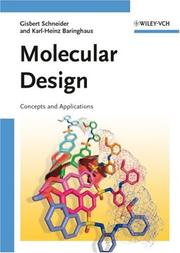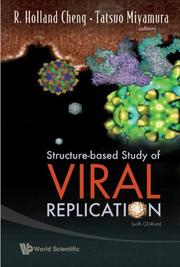| Listing 1 - 10 of 20 | << page >> |
Sort by
|
Book
Year: 2008 Publisher: Firenze : Firenze University Press,
Abstract | Keywords | Export | Availability | Bookmark
 Loading...
Loading...Choose an application
- Reference Manager
- EndNote
- RefWorks (Direct export to RefWorks)
This PhD thesis summarises a study of the nanostructuration of single molecule magnets and organic radicals on metallic surfaces, carried out by the author in collaboration with a number of research groups in Italy, France, Germany and Israel. A tailored approach was followed to graft individual molecules to the surface, to characterise the morphology of the functionalised surfaces with standard scanning probe microscopy and to investigate their magnetic properties using X-Ray circular dichroism. The aim of this project was to develop the initial basis for the organisation and addressing of magnetic molecules with a view to the development of single molecule devices for data storage and molecular-spintronic applications.
Book
Year: 2008 Publisher: Firenze : Firenze University Press,
Abstract | Keywords | Export | Availability | Bookmark
 Loading...
Loading...Choose an application
- Reference Manager
- EndNote
- RefWorks (Direct export to RefWorks)
This PhD thesis summarises a study of the nanostructuration of single molecule magnets and organic radicals on metallic surfaces, carried out by the author in collaboration with a number of research groups in Italy, France, Germany and Israel. A tailored approach was followed to graft individual molecules to the surface, to characterise the morphology of the functionalised surfaces with standard scanning probe microscopy and to investigate their magnetic properties using X-Ray circular dichroism. The aim of this project was to develop the initial basis for the organisation and addressing of magnetic molecules with a view to the development of single molecule devices for data storage and molecular-spintronic applications.

ISBN: 3527314326 9783527314324 Year: 2008 Publisher: Weinheim: Wiley,
Abstract | Keywords | Export | Availability | Bookmark
 Loading...
Loading...Choose an application
- Reference Manager
- EndNote
- RefWorks (Direct export to RefWorks)
Book
Year: 2008 Publisher: Firenze : Firenze University Press,
Abstract | Keywords | Export | Availability | Bookmark
 Loading...
Loading...Choose an application
- Reference Manager
- EndNote
- RefWorks (Direct export to RefWorks)
This PhD thesis summarises a study of the nanostructuration of single molecule magnets and organic radicals on metallic surfaces, carried out by the author in collaboration with a number of research groups in Italy, France, Germany and Israel. A tailored approach was followed to graft individual molecules to the surface, to characterise the morphology of the functionalised surfaces with standard scanning probe microscopy and to investigate their magnetic properties using X-Ray circular dichroism. The aim of this project was to develop the initial basis for the organisation and addressing of magnetic molecules with a view to the development of single molecule devices for data storage and molecular-spintronic applications.
Book
Year: 2008 Publisher: Aberdeen Proving Ground, MD : Army Research Laboratory,
Abstract | Keywords | Export | Availability | Bookmark
 Loading...
Loading...Choose an application
- Reference Manager
- EndNote
- RefWorks (Direct export to RefWorks)
Block copolymers. --- Molecular structure. --- Ion exchange.
Book
ISBN: 128196817X 9786611968175 9812814787 9789812814784 9781281968173 9812705899 9789812705891 Year: 2008 Publisher: Singapore, SG World Scientific
Abstract | Keywords | Export | Availability | Bookmark
 Loading...
Loading...Choose an application
- Reference Manager
- EndNote
- RefWorks (Direct export to RefWorks)
While the field of computational structural biology or structural bioinformatics is rapidly developing, there are few books with a relatively complete coverage of such diverse research subjects studied in the field as X-ray crystallography computing, NMR structure determination, potential energy minimization, dynamics simulation, and knowledge-based modeling. This book helps fill the gap by providing such a survey on all the related subjects. Comprising a collection of lecture notes for a computational structural biology course for the Program on Bioinformatics and Computational Biology at Iow
Computational biology. --- Structural bioinformatics. --- Structure bioinformatics --- Bioinformatics --- Molecular structure --- Biology

ISBN: 1281938475 9786611938475 9812790853 9789812790859 9789812704054 9812704051 9789812704061 981270406X 9781281938473 Year: 2008 Publisher: New Jersey World Scientific
Abstract | Keywords | Export | Availability | Bookmark
 Loading...
Loading...Choose an application
- Reference Manager
- EndNote
- RefWorks (Direct export to RefWorks)
This book addresses the innovative themes in characterizing the cellular membrane platforms and intracellular networking, as well as the architectural aspects of cell compartments mediated by the entry and replication cycles of viruses. The instrumentation of modern molecular and cellular biology provides a potent array of wave packets to image, detect and manipulate major dynamics of macromolecular and subviral assemblies as in the host cellular context. The book includes case studies presented with highly coherent and structured illuminations, including microscopy, spectroscopy and scannin
Viruses --- Molecular structure. --- Structure, Molecular --- Chemical structure --- Structural bioinformatics --- Replication of viruses --- Viral replication --- Reproduction --- Reproduction.
Periodical
ISSN: 1936122X 19361238 Year: 2008 Publisher: Palo Alto, CA : Annual Reviews,
Abstract | Keywords | Export | Availability | Bookmark
 Loading...
Loading...Choose an application
- Reference Manager
- EndNote
- RefWorks (Direct export to RefWorks)
Annual Reviews is proud to publish authoritative, analytic reviews in 37 focused disciplines within the Biomedical, Life, Physical, and Social Sciences. Annual Reviews publications are among the most highly cited in scientific literature. Annual Reviews offers publications in print and online to individuals, institutions, and consortia throughout the world.
General biophysics --- General biochemistry --- Biophysics --- Macromolecular Systems --- Molecular Biology --- Molecular Structure --- Structure-Activity Relationship --- Biomolecules --- Molecular structure --- Biophysique --- Biomolécules --- Structure moléculaire --- Periodicals. --- Périodiques --- Biophysics. --- Biomolecules. --- Molecular structure. --- Biofysik --- Macromolecular systems --- Molecular biology --- Life Sciences --- Biology --- Biomolécules --- Structure moléculaire --- Périodiques --- Structure, Molecular --- Biological physics --- Biological molecules --- Mechanobiology --- Biophysik --- 4006891-2 Biophysik --- Zeitschrift --- Physikalische Biologie --- Chemical structure --- Structural bioinformatics --- Medical sciences --- Physics --- Molecules --- Biophysikalische Therapie --- Bioengineering --- Biomedical Engineering --- Biophysik.
Book
ISBN: 1281795712 9786611795719 0080569943 9780080569949 9781281795717 6611795715 0444520171 9780444520173 Year: 2008 Publisher: Amsterdam ; Boston : Elsevier Science,
Abstract | Keywords | Export | Availability | Bookmark
 Loading...
Loading...Choose an application
- Reference Manager
- EndNote
- RefWorks (Direct export to RefWorks)
Gas phase molecular spectroscopy is a powerful tool for obtaining information on the geometry and internal structure of isolated molecules as well as on the interactions that they undergo. It enables the study of fundamental parameters and processes and is also used for the sounding of gas media through optical techniques. It has been facing always renewed challenges, due to the considerable improvement of experimental techniques and the increasing demand for accuracy and scope of remote sensing applications. In practice, the radiating molecule is usually not isolated but diluted in a
Molecular spectroscopy. --- Collision spectroscopy. --- Molecular structure. --- Structure, Molecular --- Chemical structure --- Structural bioinformatics --- Spectroscopy, Collision --- Collisions (Nuclear physics) --- Spectrum analysis --- Spectroscopy, Molecular --- Molecular spectra --- Spectroscopie moléculaire --- Spectroscopie de collision --- Structure moléculaire --- ELSEVIER-B EPUB-LIV-FT --- Molecular spectroscopy --- Collision spectroscopy --- Molecular structure
Book
ISBN: 1283438321 9786613438324 0387734708 0387734694 0387566481 Year: 2008 Publisher: New York, NY : Springer New York : Imprint: Springer,
Abstract | Keywords | Export | Availability | Bookmark
 Loading...
Loading...Choose an application
- Reference Manager
- EndNote
- RefWorks (Direct export to RefWorks)
Prof. McClain has indeed produced "a new kind of tutorial book." It is written using the logic engine Mathematica, which permits concrete exploration and development of every concept involved in Symmetry Theory. The book may be read in your hand, or on a computer screen with Mathematica running behind it. It is intended for students of chemistry and molecular physics who need to know mathematical group theory and its applications, either for their own research or for understanding the language and concepts of their field. The book has three major parts: Part I begins with the most elementary symmetry concepts, showing how to express them in terms of matrices and permutations. These are then combined into mathematical groups. Many chemically important point groups are constructed and kept in a Mathematica package for easy reference. No other book gives such easy access to the groups themselves. The automated group construction machinery allows you to tabulate new groups that may be needed in research, such as permutation groups that describe flexible molecules. In Part II, mathematical group theory is presented with motivating questions and experiments coming first, and theorems that answer those questions coming second. You learn to make representations of groups based on any set of symmetric objects, and then to make Mathematica operators that carry out rep construction as a single call. Automated construction of representations is offered by no other book. Part II follows a reconstructed trail of questions, clues and solid results that led Issai Schur to a complete proof of the Great Orthogonality. In Part III, the projection operators that flow from the Great Orthogonality are automated and applied to chemical and spectroscopic problems, which are now seen to fall within a unified intellectual framework. The topics include chemical bonding in symmetric molecules, molecular vibrations and rigorous reasoning about quantum mechanical matrix elements. As a concrete example of the enormous power of the automated projectors, the tensor operators for two- and three- photon processes are projected under all tabulated groups. All the machinery presented is general, and will work with new groups that you may construct. Finally, there is machinery that accepts as input the multiplication table of any group and returns as output its character table. This will be of great use to spectroscopists who deal with flexible molecules belonging to permutation groups, which are too numerous even for a Mathematica package.
Symmetry (Physics) --- Group theory. --- Mathematica (Computer file) --- Groups, Theory of --- Substitutions (Mathematics) --- Invariance principles (Physics) --- Symmetry (Chemistry) --- Physics. --- Physical chemistry. --- Chemistry, Physical and theoretical. --- Nuclear physics. --- Atomic structure. --- Molecular structure. --- Spectra. --- Particle and Nuclear Physics. --- Theoretical and Computational Chemistry. --- Theoretical, Mathematical and Computational Physics. --- Group Theory and Generalizations. --- Physical Chemistry. --- Atomic/Molecular Structure and Spectra. --- Algebra --- Conservation laws (Physics) --- Physics --- Chemistry. --- Chemistry, Physical organic. --- Chemistry, Physical organic --- Chemistry, Organic --- Chemistry, Physical and theoretical --- Physical sciences --- Mathematical physics. --- Atomic structure . --- Molecular structure . --- Structure, Molecular --- Chemical structure --- Structural bioinformatics --- Structure, Atomic --- Atomic theory --- Chemistry, Theoretical --- Physical chemistry --- Theoretical chemistry --- Chemistry --- Atomic nuclei --- Atoms, Nuclei of --- Nucleus of the atom --- Physical mathematics --- Mathematics
| Listing 1 - 10 of 20 | << page >> |
Sort by
|

 Search
Search Feedback
Feedback About UniCat
About UniCat  Help
Help News
News